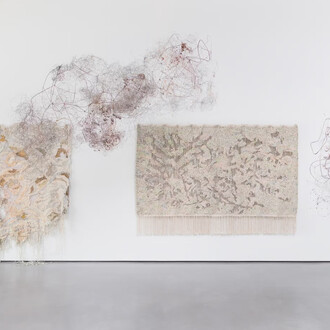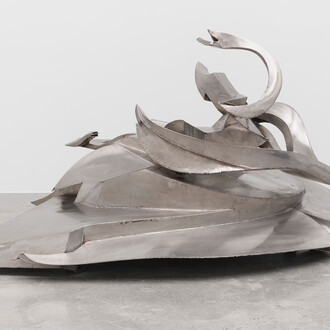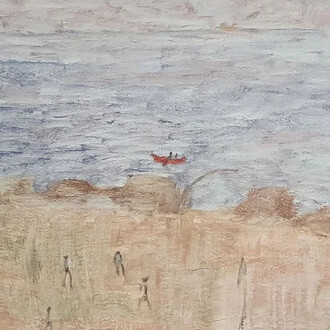Reverse: Rewriting culture seeks to review the body of work of contemporary gay artists that freed from any fig leaf are proposing a horizontal reading about gender, sexuality, social concerns, and ontological issues. This exhibition is the first edition of the ambitious project “ONE WAY”, that in each edition will call a group of artists whose sexual orientation does not correspond to the dominant stereotype of heterosexuality, neither with the wild spread misconception that reduce the production of gay artists to homoerotic contents. Reverse: Rewriting culture seeks to avoid incurring two extended stereotypes and therefore errors that dominate the approach to this kind of production that include, but are not limited to the following misconceptions: Concealment or silencing of sexual orientation of the author, or by the contrary, Confinement and reduction to the mere erotic commentary that silences or minimizes the social implications that motivates these works placing them away from general social channel where definitely belong these proposals.
Janet Batet, Cuartor:
Janet Batet (Havana, 1970) is an independent curator, art critic and essayist born in Havana, Cuba, and currently living in Miami. She is a former researcher and curator at the Centro de Desarrollo de las Artes Visuales (Development Center of Visual Arts) and professor at the Instituto Superior de Arte (Higher Institute of Art), both in Havana. A member of the curatorial team that laid the foundation for the Contemporary Cuban Art Salon based in Havana, Batet also worked as a specialist in Caribbean art for the first Biennial of Montreal. She is passionate about contemporary art, Latin American art and new technology
Batet’s essays have also been published in major anthologies of Cuban art, including Nosotros los más infieles: Narraciones críticas del arte cubano 1993–2005 (We, the Most Unfaithful: Critical Narrations on Cuban Art 1993– 2005), Andres Isaac Santana, editor; CENDEAC, 2006; and Antología de textos críticos: El nuevo arte cubano (Anthology of Critical Essays: The New Cuban Art), Magaly Espinosa and Kevin Power, editors; Perceval Press, Santa Monica, 2006.
Other writings have appeared in numerous art magazines, journals, catalogs and books in the United States, Latin America and Europe. Her articles on art practices are regularly published in Arte Al Día International, Art Nexus, El Nuevo Herald, Cuban Art News, Arts on Cuba, Art Pulse, Wynwood Art Magazine, Knight Art Foundation Miami, Art Experience NYC, Casa Galería, Lo que Venga, Memorias de la Postguerra, among others.
Consuelo Castañeda, (La Habana – Cuba, 1958)
Interested in the deconstruction and revision of the history, Consuelo Castañeda is one of the pioneers of the New Cuban Art Movement. Deeply rooted in the conceptual art tradition, her proposal embraces the pastiche as an effective method of resemantization. This engaged postmodern remix allows the outstanding critical commentaries about art and society that typifies Castañeda’s artwork. She has extensively exhibited in the United Sates and abroad. Her work is part of the Part of the permanent collections of Perez Art Museum of Miami (PAMM), Miami; Museo Nacional de Bellas Artes, Havana; Ludwig Forum Für Internationale Kunst, Aachen; Howard Farber Collection, New York
David Rohn, (Englewood, New Jersey – USA, 1951)
David Rohn grew up in the suburbs of New York, the city in which he lived during most of the ’70’s and ’80’s. He studied Architecture, Art and Urbanism at NYU, the Ecole des Beaux Arts, and Pratt Institute, he moved to Paris again in 1989, and settled in Miami in 1992 where he began to exhibit paintings, videos, installations, and performances. Associated with Carol Jazzar Contemporary Art, Miami, since 2008, his work and often-interactive performances have reached a number of museums, galleries and collections both public and private.vIn 2008, he formed: ”Homo-Sapiens (Art for Evolution)”, a collaborative entity, with Danilo de la Torre for the creation and production of inclusive collaborative performance, Video, and Photographic projects, typically with themes related to the intersection of personal and social issues.
Eduardo Ribera Salvatierra, (Santa Cruz de la Sierra – Bolivia, 1974)
Eduardo Ribera Salvatierra’s conceptual art projects range from photography to installations. Interested in creating simulations that generate a sense of hyper-reality, Rivera Salvatierra takes over the city as its real and symbolic platform. Graduated from Architecture at Universidad Nuestra Señora de La Paz, Bolivia, he has been awarded the Grand Prix Pedro Domingo Murillo; World Bank International Award; and the FOMEA Connart Award, Bolivia.
One of the works presented by Salavtierra:
Gato por Liebre / (“a pig in a poke”)
Ribera Salvatierra’s piece “Gato por Liebre” (in English “a pig in a poke”) is an interpellation about liberties and boundaries pushed and defined by artists. Salvatierra traveled from Santa Cruz, Bolivia, to the 29th Biennale Sao Paulo, Brazil, that stood out for the political content of the exhibited works. One of the most controversial pieces was "Enemies" by Brazilian artist Vicente Gil, integrated by nine self-portraits showing the time in which nine powerful personalities were about to be killed.
Salvatierra intervened the piece in which George W. Bush is with his hands tied and about to be throat cut, replacing his face by the face of Evo Morales, Bolivia's current president.
To perform the action, the artist carefully studied schedules of security personnel and camera system to avoid being arrested on the spot. The action immediately aroused the media attention in both countries becoming headline news in his homeland.
Fernando Bayona Gonzalez, (Montizón, Jaén – Spain, 1980)
Bayona's photographic essays focus on relationships and the identity of the subject. In his works he explores the most essential foundations that constitute the psychology of human beings, and the hierarchical social system that he has created for himself, and at the expense of individual liberty. Graduated from NABA University, Milan and Universidad de Granada, Granada, Bayona’s artwork has been extensively exhibited in Europe and abroad. Bayona has been awarded the California University Artistic Production Fellowship; Biennial of Photography of Córdoba Best Photography Project; Artistic Production Fellowship, Eberhard, Eberhard & Co, Switzerland; Artistic Exchange fellowship, Human Academy Kabushiki Kaisha, Osaka, Japan, among others. Fernando Bayona’s work is part of the permanent collections of SONY Contemporary Art Collection, UK; FORMA Contemporary Art Collection, Italy; BSI Bank Collection, Suiza; (CA2M), Madrid.
About the work he is presenting: Paragraph 175 is a photographic series that takes its title from the Article 175 of the German penal code (§ 175 StGB-Deutschland) is included, through which homosexual relationships between male persons were punished. This legal rule was in force in Germany since January 1, 1872 until June 11, 1994.
In 1935, the Nazi regime hardened the content of this article increasing the maximum penalty of six months to five years in prison and extended the relates activities with reprehensible acts under the law. Initially only referred to sexual activity (all kinds of "obscene" actions), but the new paragraph 175a, designed for "aggravated cases," he prescribed penalties of one to ten years hard labor.
Homosexuality was harshly repressed for being considered a sign of racial degeneration that could be passed from one individual to another meaning a serious threat to the population. In this unprecedented effort to find a remedy, the Nazis began a medical program based on multiple surgical and pharmacological experiments intended to cure and prevent homosexuality.
Around 140,000 men were treated under the different versions of this article 175, to which should be added an unknown number of women.
The images comprising this project document the exact locations where these practices were held: dwellings of the concentration camps of Sachsenhausen, Ravensbrück and Buchenwald in Germany; Auschwitz, Treblinka, Belzec, Majdanek and Stutthof Poland; Mauthausen-Gusen in Austria; Jasenovac in Croatia and San Domino Island in Italy.
The works selected for the exhibition Reverse: rewriting culture took place in the concentration camp of Sachsenhausen, Germany. These images correspond to the room where the patients were inoculated with drugs for medical experiments, the room where the bodies were cleaned prior to dissection, the room where the autopsy was practices and the morgue. Finally the piece "The sink" in an analogy invoking Pontius Pilate's washing of his hands as a metaphor between German society and international high religious authorities that disregarded such atrocities.
Fernando García, (Puerto Padre – Cuba, 1955. Died in Miami – USA, 1989)
Ranging from painting, sculpture, mixed media to installation and performance, Fernando García’s artwork is deeply connected to live and community in Miami. Member of The Miami Generation and the group NADA, this visionary conceptual artist was a pioneer in the local scene, inspiring generations of artists. He was art instructor at Miami-Dade Community College and the International Fine Arts College in Miami. Fernando Garcia’s works are part of the permanent collections of the Miami-Dade Public Library, Miami Dade College and the Museum of Art in Fort Lauderdale, among others. Making Purple, a neon piece, is at the Okeechobee Metrorail Station as part of Miami-Dade’s Art in Public Places program. He awarded the Cintas Fellowship in 1978. He died in 1989, at the early age of 44.
Tribute to Fernando Garcia and MADA’s Group:
Fernando García (b. 1945, Havana-d. 1989, Miami): is one of the most influential contemporary artists of Miami. A conceptual artist deeply involved with civic life in Miami, García’s artwork often involved the whole community. He created Holiday Spheres to float over the Miami-Dade Cultural Center during its opening, and organized the city’s literary community for his Miami Reading Symphonies for the public library system. Garcia graduated of Science in Mathematics at the University of Georgia, Athens, 1968 and Studies of Drawing and Painting at the Georgia State University, in Atlanta, 1972-1976 where eh gradated with honors. During his short yet prolific career (from 1976 to 1989) he made more over twenty extinctions and was selected for public commissions all around South Florida.
He was an art instructor at Miami-Dade Community College and the International Fine Arts College in Miami. He was part of the two historic groups that revolutionize the contemporary arts in our city: The Miami Generation and NADA. His work is in the permanent collections of the Miami-Dade Public Library, Miami Dade College and the Museum of Art in Fort Lauderdale, among others. Making Purple, a neon piece, is at the Okeechobee Metrorail Station as part of Miami-Dade’s Art in Public Places program. He received the Cintas fellowship for Arts in 1978.
“Fernando Garcia was also concerned with art as it related to the surroundings of the artist and the viewers of his performances. Connections were established via long-distance telephone calls, earth excavations, hikes, maps, and calendars. His performances played with time and place. Like Beuys, he invited the viewer to think about his or her encounter with the surrounding landscape. One could not help but be intrigued, frustrated, and finally refreshed by this provocative challenge.”
Jonathan Wahl, (Abington, Pennsylvannia – USA, 1968)
Jonathan Wahl’s artwork ranges from sculpture to decorative arts. His work has been featured at the New York Times, Art in America, The New Yorker, Oprah Magazine, W Jewelry, the Philadelphia Inquirer, Metalsmith magazine, Harpers Bazaar and the Advocate, among others. Wahl has been awarded the Louis Comfort Tiffany Emerging Artist Fellowship from the Louis Comfort Tiffany Foundation, two New York Foundation for the Arts Fellowships one for Craft and one for Drawing and the Pennsylvania Society of Goldsmiths Award for "Outstanding Achievement." Part of the permanent collections of the Metropolitan Museum of Art, the Houston Museum of Fine Arts of Arts and Design in NYC, he was named one of the top-10 jewelers to watch by W Jewelry in 2006. Mr Wahl’s work is exhibited both nationally and internationally.
Juan Pablo Ballester, (Camagüey - Cuba, 1966)
Juan Pablo Ballester’s artwork ranges from photography and video to curatorial projects. His works have been exhibited in numerous Museums and Galleries. Among them, Breaking Barriers. Selection from the Museum of Arts. Permanent Contemporary Cuban Collection, Museum of Art, Fort Lauderdale, Florida; Ofelias y Ulises. 49 Bienal Internacional de Venecia, (2001); Nueva tecnología, nueva iconografía, nueva fotografía, Museo Nacional Centro de Arte Reina Sofía, Palma de Mallorca, Cuenca (2004); Killing Time: An exhibition of Cuban artist from the 1980s to the present, Exit Art, New York. Ballester artwroks are part of the permanent collections of the Museo Nacional de Bellas Artes, La Habana; Ludwig Forum Für Internationale Kunst, Aachen; Museo Nacional Centro de Arte Reina Sofía, (MNCAR) Madrid; Centro Atlántico de Arte Moderno (CAAM), Las Palmas de Gran Canaria; Fonds National d’Art Contemporain, París; Howard Farber Collection, New York.
Video Presented by Ballester:
Based on a True Story "Unclassifiable Video documentary that intentionally mixes genres: terror, the video clip or video jockey. Based on a True Story uses a set of multiple potential affiliations where the result is the construction of an identity (hidden behind the camera) and targeted by clues arranged in the room that are alternately encoded. Based on a True Story is deeply related to a photographic work of the same title, which Juan Pablo Ballester began in 1997: A series of works about the condition of the contemporary individual, his space, strangeness and new relationships that involve personal frailty. A search of both the safety and evasion, in this case, in the room of the artist." M. S
Nereida Garcia-Ferraz, (La Habana – Cuba, 1954)
Nereida Garcia-Ferraz artwork ranges from painting, photography, sculpture, installation and video to collaborative arts. Graduated from the School of the Art Institute of Chicago, her work has been awarded the Ryerson Traveling Fellowship, National Endowment for the Arts Fellowship in 1985 and in 1998, The Ford Foundation, 1994. The Illinois Arts Council Visual Arts Fellowship in 1985, 1986, 1989, the Mac ArthurFoundation Media Grant in 1994 as well as The Richard Diebenkorn Teaching Fellowship from the San Francisco Art Institute in 2000 – 2001. She was nominated to Anonymous Was a Woman, 2013. Garcia Ferraz works have been exhibited in numerous Museums and Galleries around the US and abroad. Among them, Chicago Art 1945-1995 at The Museum of Contemporary Art, Paisajes de Ida y Vuelta, Museo del Chopo, Mexico City, FOCI Illinois State Museum, Museo de Arte Moderno Mexico City, and Islip Museum and is in the collection of MOMA, Guggenheim Museum, Yale University, San Francisco Art Institute and many other Museums and Universities around the world.



















